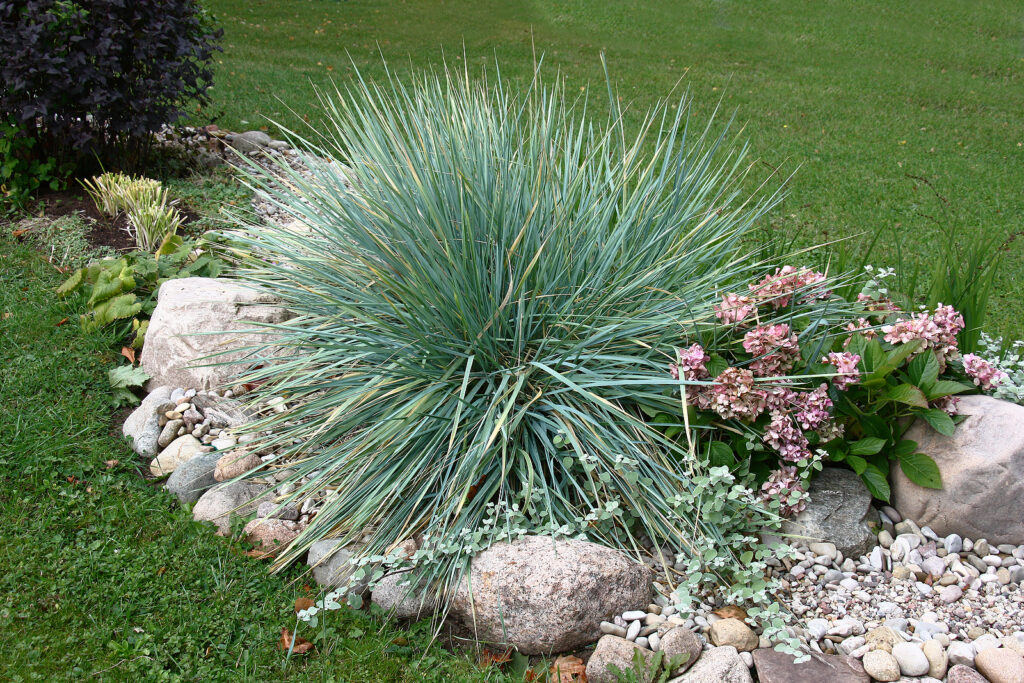Elymus, commonly known as wild rye, is a genus of grasses known for their upright stems and long, linear leaves. Elymus typically form dense, robust clumps or tufts and can grow to varying heights, depending on the species. Elymus can be found in a variety of temperate environments, from prairies to woodlands to coastal dunes.
Elymus grasses are typically perennial, cool-season grasses. Elymus grasses typically have long, slender leaves that are often bluish-green in color. The flowers of Elymus grasses are typically produced in cylindrical spikelike inflorescences and can range in color from green to purple or brown. The seed heads are usually dense, spike-like structures that can range in color from green to purple.
Elymus grasses are often used for erosion control or as ornamental plants in gardens and landscapes. Elymus grasses are known for their ability to tolerate a wide range of soil types and environmental conditions, making them a versatile and hardy choice for landscaping and restoration projects.
Elymus is a genus of grasses that are commonly known as wild rye or lyme grass. Elymus grasses are commonly found in open meadows, prairies, and along roadsides, and are known for their ability to thrive in a wide range of soil types and environmental conditions. Elymus belongs to the Poaceae, or grass family.

Get to know Elymus
- Plant type: Grass, evergreen or semi-evergreen
- Growing zones and range: Zones 2-9
- Hardiness: Frost and freeze hardy
- Height and width: 2 to 6 feet tall and 2 to 4 feet wide depending on maturity
- Foliage: Bright blue, gray leaves; changes from blue to yellow to bright beige in cold weather
- Flowers: Beige flowers
- Bloom time: Early to late summer
- Uses: Specimen in flower garden; mass plant for erosion control
- Common name: Wild rye, lyme grass
- Botanical name: Elymus
- Family name: Poaceae
- Origin: Northern Hemisphere
Where to plant Elymus
- Elymus grasses prefer full sun to partial shade and well-drained soil.
- Choose a spot in your garden that receives at least 6 hours of sunlight per day and has good drainage.
- Elymus can tolerate a wide range of soil types, including sandy, loamy, and clay soils.
- Before planting Elymus seeds or seedlings, amend the soil with organic matter such as compost or aged manure to improve the soil structure and fertility.
When to plant Elymus
- Set container-grown Elymus plants in the garden in spring or fall.
Planting and spacing Elymus
- Elymus grasses can be planted from seed or from nursery-grown plants. Plant seeds in early spring or fall, following the instructions on the seed packet. If planting seedlings, space them about 12 to 18 inches apart to allow for proper growth.
- If planting Elymus seeds, sow them directly in soil that has been loosened from 6 to 8 inches deep and cover lightly with a thin layer of soil. If using seedlings, transplant them into the soil at the appropriate spacing (usually around 18 to 24 inches apart).
- Before planting Elymus seeds or plugs, prepare the soil by tilling it to a depth of 4 to 6 inches and removing any weeds or debris. Add organic matter, such as compost or aged manure, to improve soil fertility and drainage.
How to water and feed Elymus
- Water newly planted Elymus grasses regularly to help establish their roots. Once established, Elymus is drought tolerant and only needs occasional watering during dry periods.
- Fertilizing: Elymus grasses do not require much fertilization. A light application of a balanced fertilizer in spring may help promote growth.

Elymus care
- Elymus grasses are low-maintenance and generally do not require much care. However, you may need to trim back any dead or damaged foliage in the spring to promote new growth. Cut back the grass to a height of 4-6 inches in the fall or early spring.
- You can regularly mow Elymus grass to keep it at the desired height and prevent it from becoming too unruly. You can also fertilize the grass in the spring with a balanced fertilizer to promote healthy growth.
Elymus pests and diseases
- Elymus is usually pest and disease free. Keep an eye out for any pests or diseases that may affect the Elymus grass and take appropriate measures to control them if necessary.
Elymus propagation
- Eymus spreads by rhizomes.
- Plant bare-root or container-grown Elymus plants in spring.
- Elymus grasses can be divided every few years to rejuvenate the plants and prevent overcrowding. Simply dig up the clumps in early spring or fall, divide them into smaller sections, and replant them.
Elymus varieties to grow
- Elymus arenarius ‘Glaucus’ called wild blue rye; grows 1 to 2 feet tall and 2 to 4 feet wide; bright blue-gray leaves turns yellow to bright beige in winter; beige flowers are insignificant in summer.
- E. condensatus ‘Canyon Blue’ is a California native with grey-greey foliage; grows 3 to 4 feet tall; is not invasive.
- E. magellanicus, Magellan wheatgrass; clump-forming grows 18 inches tall and wide with metallic blue leaves; probably the bluest of all grasses,















